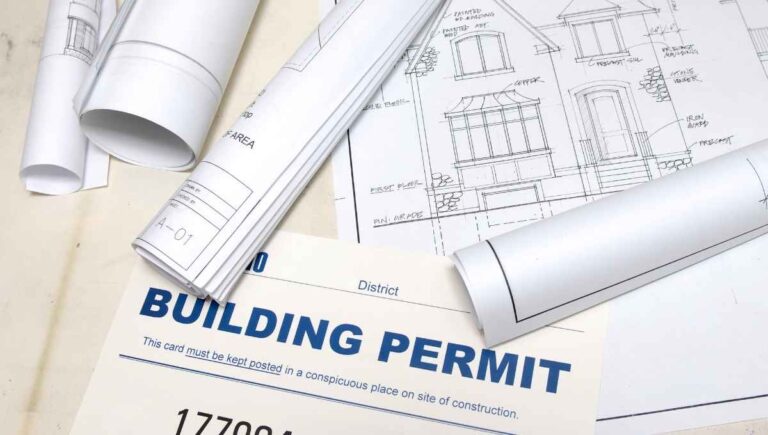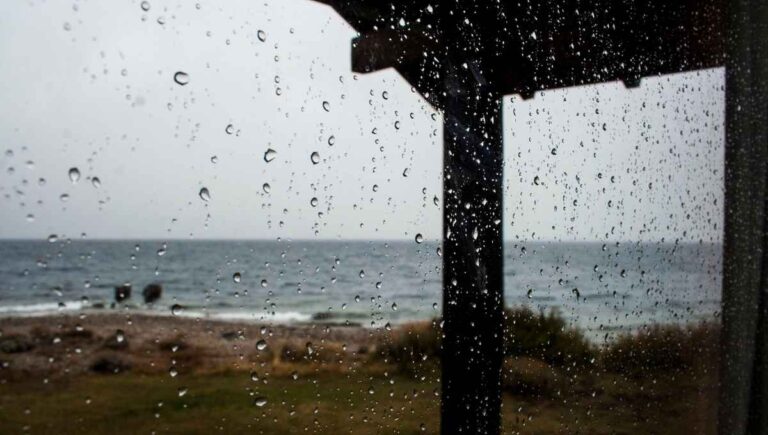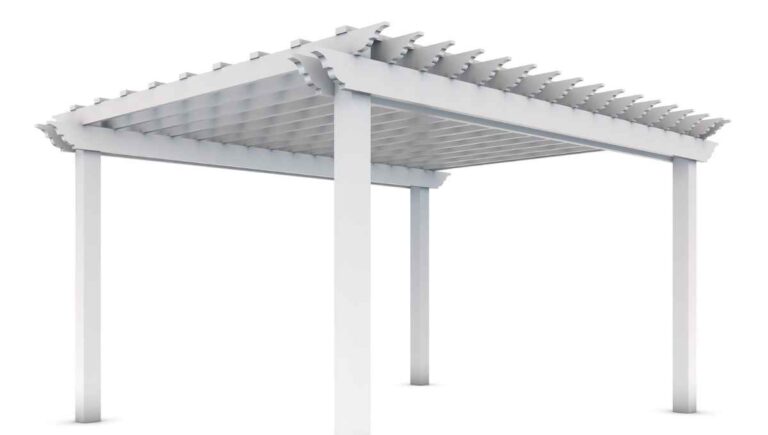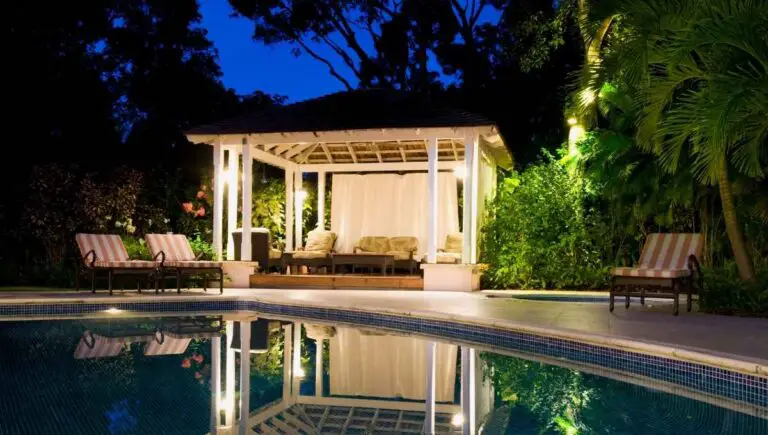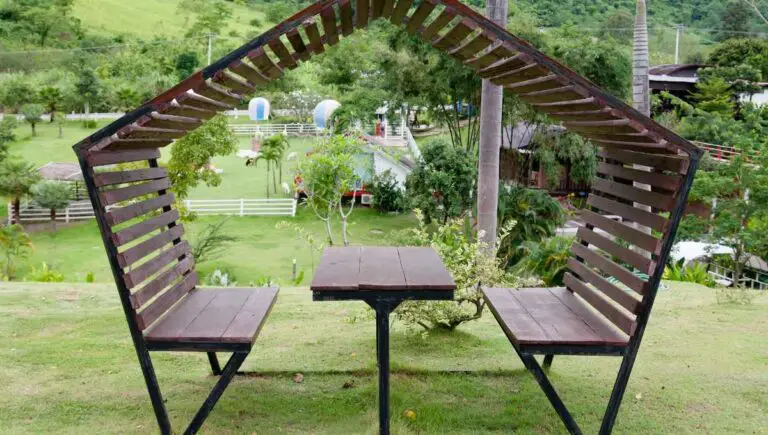Can a Gazebo Withstand Snow? (Protecting Gazebos in Winter)
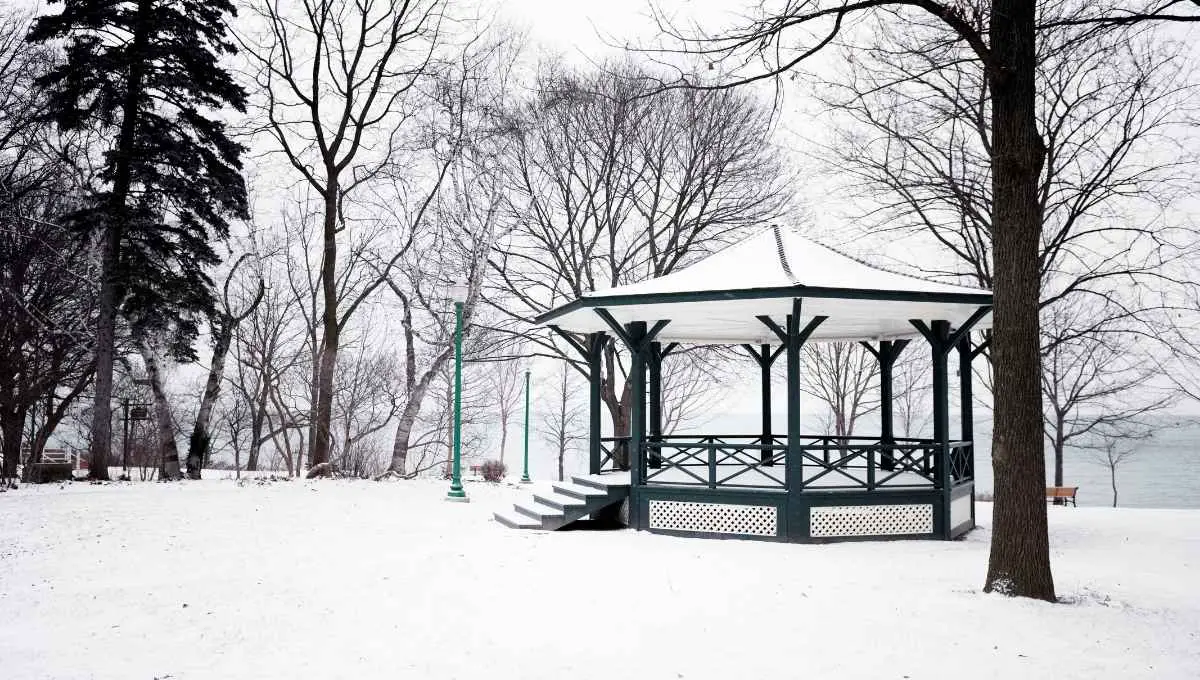
Gazebos add a lot of character to a yard or garden, but some are not built to be very sturdy. If snow and other weather concerns can affect the roof of a house, how much more can it affect a gazebo? So, it is logical to wonder if a gazebo can withstand snow.
Gazebos can be winterized, but you should protect your gazebo in the winter. The main concern for snow on a gazebo is water damage. If snow stays on a gazebo for the majority of the winter, it will have water damage and possibly mold and mildew.
Thankfully, there are many ways to prevent damage from snow on a gazebo. In this article, we will go over ways to winterize your gazebo, keep the snow off, and other concerns and ways to prevent damage to the gazebo during the winter. Let’s get started.
This post contains affiliate links from Amazon and other stores. This means Yard Blogger may earn a commission if you make a purchase using any of our links. Please refer to our full affiliate disclosure policy for full details.
Here’s a Quick Pro Tip!
When protecting your gazebo from the snow, you will need products that help reduce water damage and keep your gazebo’s roof from deforming under the weight of the snow. Or, you can buy a gazebo made for the snowy season.
Here are a few of our favorite ways to help your gazebo withstand harsh winter conditions this season:
1. Kozyard Hardtop Aluminum Gazebo: This gazebo was built for heavy snow and long winters. It can hold 2500 pounds of snow and can withstand at least 40 mph winds. Additionally, it is made from rust-free aluminum.
2. Gorilla Waterproof Patch & Seal Spray: This spray locks out water, moisture, and air. It also is UV resistant and can last in -40 degree temperatures. It will seal in wood, metal, vinyl, concrete, brick, tile, and more.
3. SNOWPEELER Roof Snow: This tool cuts through the snow on top of roofs and hedges without the need for a ladder. It also allows you to stand back further so that snow does not fall on top of you.
Gazebos and Snow
Gazebos are exposed to snowfall, which can damage the gazebo if it snows enough. In this section, we will go over how to winterize your gazebo and prevent damage from the snow.
If that sounds like something you want to know, keep reading!
How Do You Winterize an Outdoor Gazebo?
First, remove all items and benches from the gazebo and store them in an enclosed space. Then, thoroughly clean the gazebo and repair any damage, including filling in holes and cracks.
Removing items and filling in cracks and holes help the snow and snow melt from soaking into the wood of the gazebo. You can also cover the roof with a slick waterproof tarp if the snow tends to collect on the roof.
How Do I Get Snow Out of a Gazebo?
For the inside of the gazebo, use a snow shovel to remove any snow. If you have ice build-up, add salt to the surface to aid in melting the ice. You can do the same for the gazebo’s roof if snow and ice have built up there.
You can use a roof rake to remove the snow. They extend to reach tall heights. It’s best to wear a hat for this because the snow may fall on you. You can also throw roof melt on icy parts to better melt the ice. It comes in puck-shaped tablets that are easy to throw on the roof.
How Do You Prepare a Gazebo for Winter?
To prepare your gazebo for winter, fill in any cracks or holes. This will prevent water from snow melt from seeping into the wood, as the water may create water damage and rot your wood. Also, clean your gazebo well and remove anything that would soak up water.
You can also use a heater on freezing nights to prevent the snow from freezing and turning into ice sheets. You can also place an emergency blanket over the gazebo on freezing nights.
This will also help the snow slide off the roof rather than sticking on the roof.
You might also enjoy our post on If a Gazebo is Safe in the Wind
How Do You Winterize a Screened Gazebo?
The best and easiest way to winterize a screened gazebo is to put up plastic vinyl panels. This will insulate the gazebo and keep it from freezing or collecting snowfall. You can also cover the roof with plastic vinyl to keep snow from collecting on the roof.
It’s also best to thoroughly clean the gazebo to prevent mold and mildew from growing on top of organic residue. Additionally, fill in any holes or cracks with wood filler to prevent water from snowfall from melting and collecting in the cracks.
Are There Gazebos That Can Withstand Heavy Snow?
Heavy-duty aluminum gazebos are the best for withstanding heavy snow and other weather conditions. However, you want to have strong legs and anchors as well. Steel is strong too, but it will rust, whereas aluminum does not.
Wooden gazebos with tar shingles work well too, but over time the snow melt will warp the roof and can rot the wood. Be sure to treat wood gazebos with a waterproof sealant to prevent rot.
Also, you can buy a fabric gazebo and enjoy it during the warm months, then take it down and store it in the cold months.
What is the Best Hard Top Gazebo for Snow?
The best hard-top gazebo for snow is aluminum gazebos. The aluminum doesn’t rust and, if built strong enough, can withstand over 2000 pounds of snow. You also want a gazebo with strong legs and anchors that will stand against heavy winds.
When considering snowfall and keeping the gazebo out all winter, you also want to consider whether it can stand up to high winds.
Also, if a gazebo is made of aluminum and can withstand high winds, it can withstand most other weather conditions.
Winterize
You have to store or winterize many things before it gets too cold, including your gazebo.
However, after reading this section, you won’t have to worry about what to do to winterize the gazebo because we will walk you through how to winterize any type of gazebo.
Do I Need to Take My Gazebo Down for the Winter?
If you have a temporary structure made of fabric, then you want to bring it in for the winter. However, if you have a permanent wood or aluminum structure, you can leave it up all winter.
Aluminum gazebos don’t need to be winterized, either. However, you will want to bring in any furniture or curtains. Additionally, if you have a wooden structure that is already sealed with a waterproof sealant, you just need to worry about any cracks that have started.
Do You Have to Take Down a Gazebo in the Winter?
If your gazebo is a permanent structure, you should winterize it where it stands, but if you have a removable gazebo, then it will be easier and better for the gazebo for you to take it down and store it in a warmer and dry place.
If the gazebo is aluminum, then you will not need to do anything to winterize it. However, if it is made of steel, you should coat it with rust-proof sealant. Additionally, if the gazebo is made of wood, you should seal it in waterproofing sealant.
How Do You Keep Snow off a Gazebo Canopy?
To keep the snow off of a gazebo canopy, you will want to either cover it in a slick tarp the snow will slide off of or use a roof rake to remove the snow as it collects. If a lot of snow has built up on it for a week or more, use roof melt tablets to melt ice on the roof.
You can also buy an aluminum-topped gazebo that has a sloped roof. Aluminum will not rust, and it can hold up to 2,500 pounds of snow, depending on the thickness of the metal and the structure of the legs and anchor.
Can You Leave a Metal Gazebo up in the Winter?
You can leave a metal aluminum gazebo up through the winter because it will not rust and can hold thousands of pounds of snow. Steel gazebos are good, too, and do not need to be brought inside. However, steel gazebos need to be coated in rust-proof sealant.
You can also leave up a wooden gazebo with a tar shingle roof, but you will want to fill in any cracks and seal the wood with waterproof sealant.
You will also want to rake off any snow build-up so the roof will not become warped quickly from water damage.
You might also enjoy our post on If a Gazebo is Safe in Lightning
Will a Hard Top Gazebo Last all Winter?
An aluminum hard-top gazebo that is made to withstand strong winds can last all winter without water damage or rust. However, if the sides are screened in, you will want to cover the sides in plastic paneling.
You can also use custom cut and made tarp for the sides of your gazebo.
Additionally, if you have wood legs on your gazebo, ensure any cracks are filled in with wood glue or filler and then sealed with waterproof sealant.
Other Gazebo Questions
Gazebos are fairly simple, low-maintenance structures, but some maintenance issues come up, and there are ways you can prevent damage.
In this section, we cover ways to keep your gazebo weather-resistant all year long and how to keep it from freezing over in the winter.
Can a Gazebo Be Left Up All Year?
A gazebo that is a permanent build can be winterized and left up all year. If the gazebo is a heavy-duty aluminum structure that has a sturdy anchor in the ground, there’s nothing more you need to do other than bring in any curtains or furnishings from under it.
You can winterize a wooden gazebo by cleaning it thoroughly and filling in any cracks in the wood. Then you can add waterproofing wood sealer to keep out the water from snow melt.
If you have a shingle roof on it, you may need to rake the snow off during the freezing months.
How Do I Keep My Outdoor Gazebo Warm?
To keep your gazebo warm in the winter, you can insulate it by hanging a plastic tarp or plastic paneling to cover the sides and screens of the gazebo. You can also use a heater for the gazebo on nights when it’s freezing.
There are many space heaters or utility heater options, but you should always be mindful of the dangers of using a heater like that, as 81% of home heating fire deaths come from stationary or portable heaters. Follow fire safety guidelines and clean your heater of debris or build-up.
How Do You Reinforce a Gazebo?
The best way to reinforce a gazebo is to reinforce the anchor. You can put sandbags or other weights on the existing anchor. This is best on concrete surfaces. However, deeper ground anchors are best for grass.
Tents and gazebos will likely come with an anchor, but you can buy better anchors that make the structure sturdier. For example, you can buy peg anchors that will run deeper into the ground and will not wiggle free over time.
Is There a Heavy-Duty all-Season Gazebo?
Yes, there are a few kinds of heavy-duty gazebos. However, the best choice as far as durability is an aluminum gazebo. Some heavy-duty aluminum gazebos can withstand 90 mph winds. However, most aluminum gazebos can only withstand 40 mph winds.
You can also use a heavy-duty wooden gazebo or steel gazebo. However, they must be winterized and sealed first before it starts to freeze and snow.
Also, covering the gazebo in a plastic tarp or paneling will help fight the wind off the structure.
You might also enjoy our post on Are Gazebos Covered By Insurance?
Other Gazebo Concerns
Even permanent gazebos come with their issues during the winter. In this section, we will put to rest those winter concerns when it comes to making your gazebo fit for the whole winter. Let’s dig in!
What is a Permanent Gazebo?
A permanent gazebo is a structure that is not meant to be moved. Instead, it is anchored to the ground within a permanent structure, like a deck, or it is held in place with cement. However, you can also anchor a gazebo down with long, sturdy pegs.
You can take a moveable steel or aluminum gazebo, anchor it with deep pegs and strong rope and treat it as a permanent structure. The structure will stay secure as long as the material is sturdy enough and the anchor is strong enough.
Will a Steel Gazebo Rust in the Snow?
A steel gazebo will rust in the snow unless you seal it with a rust sealant. A rust sealant can keep the steel rust-free for up to ten years. You can also use rust sealant on wooden gazebos with steel bolts and other fixings.
Aluminum will not rust and generally lasts longer than steel. However, aluminum does corrode, especially when exposed to snow and rainfall. Although, aluminum typically lasts anywhere from 20 to 100’s of years.
How Long Do Aluminum Gazebos Last in the Cold?
Aluminum gazebos are likely to last much longer than ten years and up to hundreds of years. This includes many cold winters. However, aluminum can corrode over time if exposed to water with high acid content.
The ph in tap water is close to neutral in most areas, which is also true of snow or rain. This means corrosion from water takes many years at least.
However, if you are still concerned, you can further protect your aluminum gazebo using a corrosion inhibitor.
What Brand of Gazebo is Best for Winter?
Most manufacturing companies focus on wind resistance when it comes to durability, but one brand considers all aspects of winter in its design. This brand is called Kozyard, and they have gazebos that can hold 2500 pounds of snow.
Kozyard also accounts for snow melt by installing a gutter into the hardtop roof. Additionally, their gazebos are built to last and can go up against 40 mph winds and stay rust-free, and will not become warped or deformed.
Related Questions
Are Gazebos Windproof?
Gazebos made to be permanent structures should withstand 30 mph winds at least. On average, permanent gazebo structures can stand against 40 mph winds, and some can stand against 90 mph winds.
One way to further windproof your gazebo is to close it in rather than leave it open or only leave the frame. If your gazebo has built-in sides with mesh screens, you can cover the sides with a tarp or plastic panels.
Are Gazebos Waterproof?
Most gazebos are water resistant, and over time they lose their resistance. However, there are sealants and treatments you can use to waterproof your gazebo after you notice metal rust or corrosion or wood starting to warp.
If you have a wooden gazebo that is not waterproofed, then you can buy a waterproof sealant for the wood.
If you have a steel gazebo that starts to rust, Rust-oleum or other rust enamel products are good. And if you have an aluminum gazebo and notice it begins to corrode, you can use a corrosion inhibitor.
How Much Wind Can a Gazebo Withstand?
Gazebos that are not meant to be permanent structures may only stand up to 20 mph winds. However, gazebos built to be permanent structures should withstand at least 30 mph winds; some can hold up to 90 mph winds!
Fully enclosed gazebos stand against the wind the best. Gazebo structures made with hard aluminum, galvanized steel, and polycarbonate seem to do the best as well.
However, a thick wooden structure also works well, especially when it is anchored.
Final Thoughts
Thank you for reading this article. We hope it helps you and that you know the best way to protect your gazebo during the winter.
Or, if you don’t already own a gazebo, we hope this helps you choose the right one for your home!






